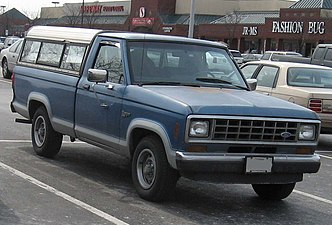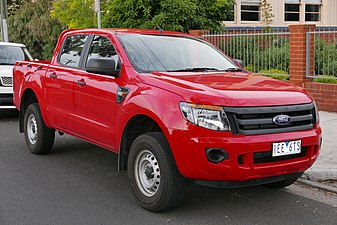| Revision as of 15:10, 17 November 2018 editEurovisionNim (talk | contribs)Extended confirmed users, Pending changes reviewers, Rollbackers27,416 edits higher quality image← Previous edit | Revision as of 14:01, 6 December 2018 edit undoEurovisionNim (talk | contribs)Extended confirmed users, Pending changes reviewers, Rollbackers27,416 edits addNext edit → | ||
| Line 47: | Line 47: | ||
| File:Ford Ranger XLT 2.5 TDCi Doppelkabine (II, Facelift) – Frontansicht, 10. September 2011, Düsseldorf.jpg|2009–2011 | File:Ford Ranger XLT 2.5 TDCi Doppelkabine (II, Facelift) – Frontansicht, 10. September 2011, Düsseldorf.jpg|2009–2011 | ||
| File:2015 Ford Ranger (PX) XL Hi-Rider 4-door utility (2015-11-11) 01.jpg|2011–2015 | File:2015 Ford Ranger (PX) XL Hi-Rider 4-door utility (2015-11-11) 01.jpg|2011–2015 | ||
| File:2017 Ford Ranger Limited.jpg| |
File:2017 Ford Ranger Limited.jpg|2015–2018 | ||
| File:Ford Ranger 2018 NAIAS.jpg|2018-present | |||
| </gallery> | </gallery> | ||
Revision as of 14:01, 6 December 2018
Ford Ranger is a nameplate that has been used on three distinct model lines of vehicles sold by Ford. The name originated in 1958, as the Edsel Ranger was slotted the base sedan of the Edsel model range (becoming the sole sedan for the final 1960 model year). From 1965 to 1981, Ranger denoted various trim packages of the Ford F-Series (and Ford Bronco), serving as a mid to top-level trim.
For the 1983 model year, the Ford Ranger nameplate was applied to a model range, as Ford introduced its own compact pickup truck, replacing the 1972-1982 Ford Courier in North America. In global markets, Ford began use of the Ranger nameplate in 1998 in place of Courier, with all compact trucks named Ranger by 2006.
For 2011, the Ranger was discontinued in the United States and Canada. The same year, Ford commenced production of a mid-size Ford Ranger; sold globally (with the exception of the United States and Canada prior to 2018), production was revived in the United States in 2018.
Americas (1983–present)
Main article: Ford Ranger (North America)For the 1983 model year, Ford introduced the Ranger for the United States and Canada. Replacing the Courier (a rebadged Mazda B1800), the Ranger was the first compact pickup truck designed by Ford. Using the same chassis architecture, three generations of the Ranger were produced across its 29-year production run. The model line underwent major redesigns for 1993 and 1998, a mid-cycle update in 1989, with smaller updates for 2001, 2004, and 2006.
The Ford Ranger chassis architecture served as the basis for several model ranges over its production. The Ford Bronco II and the 1991-2001 Ford Explorer were derived from the Ranger (alongside the Mazda Navajo and Mercury Mountaineer) alongside the 2001-2005 Ford Explorer Sport Trac. Through the use of rebadging, in North America, Mazda sold the Ranger as the Mazda B-Series from 1994-2009 (the reverse of the original Ford Courier; also the reverse of the Ford Ranger outside North America)
On December 22, 2011, the final Ford Ranger produced for North America rolled off the Twin Cities Assembly assembly line, as the final vehicle assembled at the facility.
South America (Ford Argentina)
In 1995, exports of the Ford Ranger began to select Latin and South American countries. To accommodate the demand for the vehicle, in 1998, Ford Argentina commenced local production of the Ranger, introducing a four-door cab not sold in North America. During the 2000s, Rangers produced by Ford Argentina shared a common chassis with North American-produced vehicles (offering a diesel engine to meet local demand). For 2010, the Ranger underwent a major revision of the exterior (not done for North America).
Ford Argentina ended production of the compact Ranger following the 2011 model year (slightly before the United States) to expand production of the Ranger T6 mid-size pickup, which remains in production.
Model revival (2019-present)
After an eight-year hiatus, the Ford Ranger returns to the Ford model range in North America for the 2019 model year, with the first example rolling off the assembly line at Michigan Assembly Plant on October 22, 2018. The revived Ranger is the global Ranger T6, adapted slightly to accommodate American government regulations. Similar in size to the Ford Explorer Sport Trac, the 2019 Ranger is the first generation produced as a mid-size pickup for the North American market. The Ranger is sold in two configurations, SuperCab (2+2 door extended cab with 6-foot bed) and SuperCrew (4-door crew cab with 5-foot bed); the two-door standard cab is not produced for North American sale.
As the 1983-2012 Ranger served as a basis for several Ford/Mercury/Mazda vehicles during its production, the current mid-size Ranger will serve as the basis for the revived Ford Bronco (slated for a 2020 introduction).
-
 First generation (1983-1988)
First generation (1983-1988)
-
 First generation facelift (1989-1992)
First generation facelift (1989-1992)
-
 Second generation (1993-1997)
Second generation (1993-1997)
-
Third generation (1998-2000)
-
 Third generation, third facelift (2006-2012)
Third generation, third facelift (2006-2012)
-
 South America (2010-2012)
South America (2010-2012)
-
 Fourth generation (2019- )
Fourth generation (2019- )
International (1998–present)
Main articles: Mazda B-Series, Mazda BT-50, and Ford Ranger (T6)For markets outside of North America, Ford badge engineered the Japanese-built Mazda B-Series as the Courier starting in 1971, renaming it the Ranger in 1998 (with the exception of Australasia where the Courier nameplate was retained until 2006; incidentally the Courier was also sold in North America prior to the 1983 model year). Second-generation Ranger models from 2006 to 2011 were also designed by Mazda, being rebadged versions of the successor to the B-Series, the first generation BT-50.
Third-generation models, as produced since 2011, were designed and engineered by Ford Australia, with this time the Mazda badged variant being the derivative version of the Ford, offered as the second generation BT-50. This third generation is also the basis for the Ford Everest SUV and therefore, the Ranger and the Everest share a number of features. Third generation Ford Ranger and particularly its most expensive flagship version (the Ranger "Wildtrack"), has vastly increased its presence on the European market, making the Ranger the best selling pickup truck in Europe by 2015.
For the 2019 model year, the Ranger T6 commences sales in North America, with several external and internal changes to adapt to government regulations and market demands.
References
- "Ford Ranger - Overview". Detroit Auto Press. Retrieved 27 May 2018.
- Max, Josh (19 December 2011). "Ford Ranger, other cars, cease production in 2012". New York Daily News. Retrieved 26 December 2014.
- "2019 Ford Ranger production starts in Michigan". Roadshow. 2018-10-22. Retrieved 2018-10-23.
- Ford NAIAS 2017: Official Press Conference Livestream
If an internal link incorrectly led you here, you may wish to change the link to point directly to the intended article.
| Ford vehicles | |||||||||||||||||||||||
|---|---|---|---|---|---|---|---|---|---|---|---|---|---|---|---|---|---|---|---|---|---|---|---|
| Current models |
| ||||||||||||||||||||||
| Former models (by date of introduction) |
| ||||||||||||||||||||||
| Military | |||||||||||||||||||||||
| Related topics | |||||||||||||||||||||||





